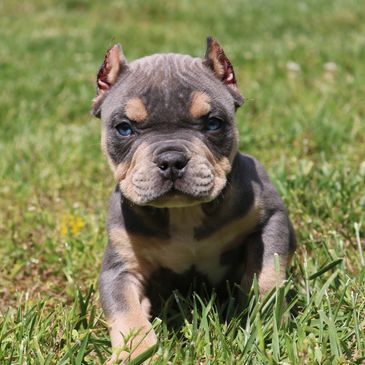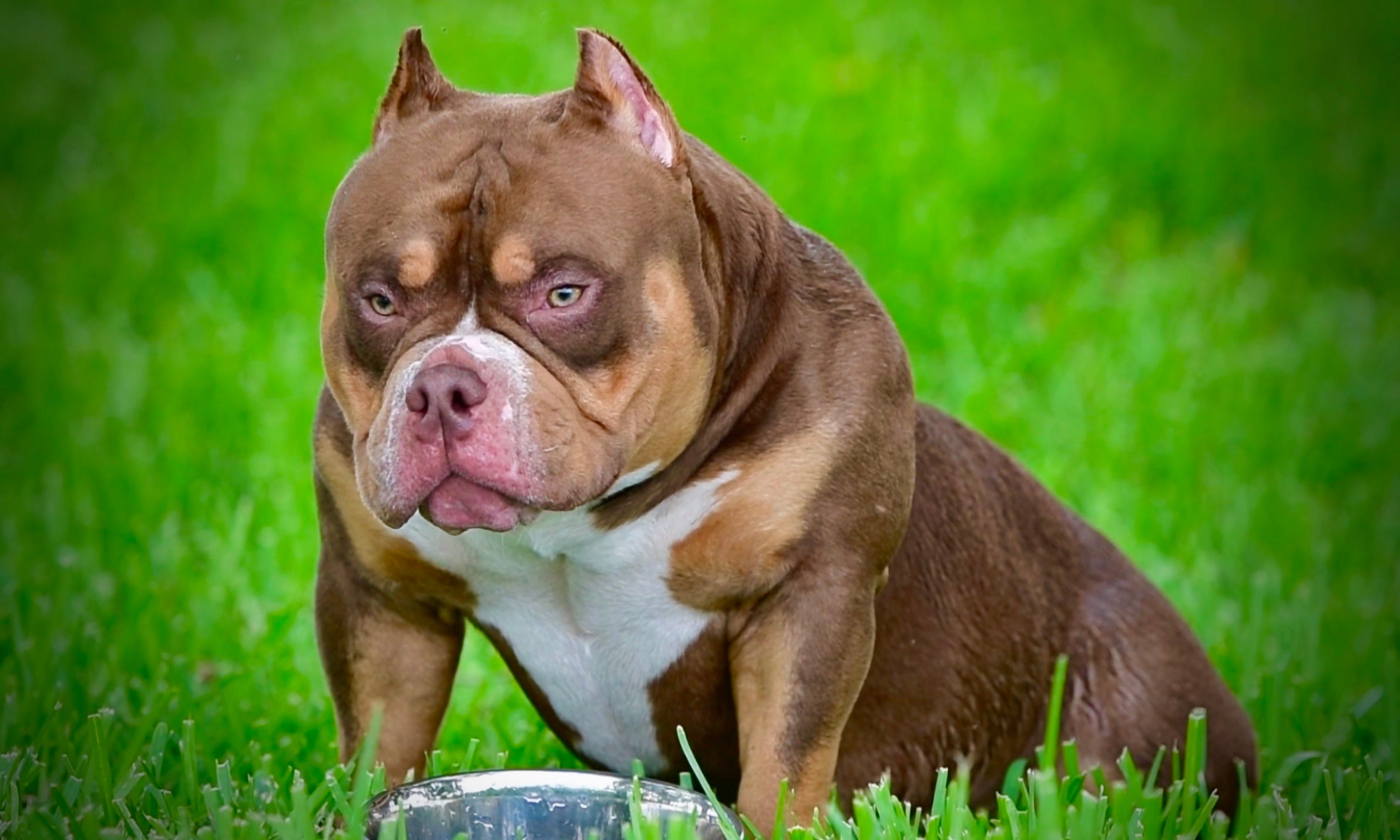Last Updated on July 2, 2021 by Fumipets
Hundreds of dog breeds exist across the globe. Different kennel associations recognise different dog breeds. The kennel club acknowledges breeds that are suitable for keeping as pets. Dogs are popular pets because of their loyalty and devotion to their owners. Having a dog as a pet is a wonderful experience. When you see your pet adoring you the most, your heart is overwhelmed with love and appreciation. Their whole universe revolves around their master, and there is nothing more lovely than having your companion dog show love in its own special manner.
Dogs are often affectionate creatures. Many breeds may seem frightening, yet they are caring and devoted. The Pocket Bully is a breed of dog that is warm, loyal, and sociable. It has grown in popularity in recent decades as a result of its physical characteristics. A dog is a man’s best friend, and a Pocket Bully is a perfect example of this.
What is a Pocket Bully?
Dogs come in a variety of sizes, from huge to little, and even small enough to fit in your luggage and carry about. The Pocket Bully, also known as the Tiny Pit Bull, is a tiny dog that is a miniature version of the American Pit Bull Terrier. It is becoming increasingly well-known as a result of its Pit Bull-like form and small size, which allows it to be handled effortlessly. They are affectionate and loyal, making them a wonderful choice for a pet.
Are you seeking a little dog with a fearsome appearance? Pocket Bully is the dog for you if you want to maintain a Pit Bull but are concerned about its size. This article will teach you all you need to know about a Pocket Bully so you can decide whether or not to keep it as a pet.

What breeds are used to create a Pocket Bully?
The American Pit Bull Terrier and the Patterdale Terrier are the progenitors of the Pocket Bully. Patterdale and Pocket Pitbull are other names for this breed. It is tiny, with the build of an American Pit Bull and the height of a Patterdale Terrier. It’s an exotic dog, which explains why it’s so expensive.
A huge dog, the American Pit Bull Terrier weighs between 35 and 60 pounds and stands between 18 and 21 inches tall. On the other hand, a Patterdale Terrier is a little dog with a height of 9-15 inches and a weight of 11-13 pounds approximately. The physique of the American Pit Bull is combined with the height of the Patterdale Terrier to create the Pocket Bully.
Origins
The Pocket Bully is a hybrid dog, not a purebred. As a result, it’s impossible to say where they came from in the first place. Over time, unplanned copulation of Patterdales with American Pit Bulls may have resulted in the creation of this breed.
The goal of combining an American Pit Bull Terrier with a Patterdale Terrier was to produce a companion dog for the family. Around two decades ago, they were purposefully created to combine the best qualities of both dog breeds. However, the resultant breed may also pass on unfavourable features.

Appearance
The Pocket Bully is a little dog with a hard, solid physique. Pocket Bullies are extraordinarily muscular, and their muscular bodies are a sight to behold. It has a glossy finish that is simple to keep clean. It has a short, thick, silky coat. A detailed look at the physical attributes of the Pocket Bully is presented below;
Height and Weight
The pocket Bully is a tiny dog, as the name implies. Some people believe it is tiny enough to fit in their pocket, however, this is not the case. When compared to its parent breeds, it is somewhat smaller. Pocket males are under 17 inches tall, while females are under 16 inches tall. A fully grown Pocket male weighs between 11 and 22 pounds. And the female is between 10 and 20 pounds.
Masculinity
Pocket bullies are small in stature, yet they have the same intimidating appearance and robust build of the American Bully. It is recognised for having a muscly form and bearing a strong figure. They have a thick neck and a huge, broad head. Their chest is large, yet shallow when compared to other breeds. They have a low-level back and short, strong legs.
Their ears are short and floppy, and their backs are solid and strong. They have a slender medium-length tail. When you see a Pocket Bully, you may imagine a smaller version of an American Pit Bull going along the street. They have a well-built, meaty, and robust appearance.
Available Colours
Pocket Bullies are available in a wide range of colours. They might be plain colour or contain secondary colour marks. They may also have blue ticking. Red, Blue, Fawn, Black, Black & Tan, Blue & Tan, Brown, Buckskin, White & Seal, and many more colours are available.
Coat
Because this is a mixed breed, it is impossible to determine the coat type. The coat of an American Pitt Bull is short and silky, with no undercoat. The Patterdales have a coarse, thin coat, but a thick undercoat that protects them from the cold and severe weather.
The Pocket Bullies, like American Pitt Bulls, have a short and silky coat. However, they may also take the coat from a Patterdale variety. As a result, the grooming of Pocket Bullies is determined by the coat type.
Life expectancy
A Pocket Bully has an average lifetime of 11-13 years. They can live longer if they are properly cared for; they need a healthy lifestyle, enough of room to run about, and balanced food to live longer than the average age.
Sexual Maturity
By the time they are six months, a male Pocket Bully has become reproductive. They usually attain sexual maturity between 12 and 15 months. When healthy male Pocket Bulls achieve sexual maturity, they may mate at any time. They have the ability to impregnate female canines of any age. Even in old age, a healthy male pocket bull may remain sexually active and fruitful.
Similarly, a female Pocket Bully may reach maturity as early as six months or as late as two years. It may happen at any moment between the ages of 6 and 24 months. The heat cycle is referred to as oestrus. It may happen to female dogs at any age after six months. During oestrus, female dogs are the most fertile, and they accept male dogs.
The female dog’s oestrus happens every six months until she reaches old age. The most important consideration is that the female dog not be bred during her first cycle. A female Pocket Bull’s cycle is divided into four parts:
Proestrus:
The female Pocket Bull will attract male dogs at this time. Her vulva will remain enlarged and she will continue to have a bloody vaginal discharge. This stage lasts about nine days. The female dog will not allow breeding at this period.
Estrus:
When a female dog is in heat, she is fertile and willing to accept male dogs. Ovulation usually occurs during the first 48 hours, however this varies from dog to dog. This time is almost nine days long.
Diestrus:
Because progesterone is controlled by the reproductive system, female dogs are more likely to get pregnant during this time. Even if she hasn’t conceived, the female dog may exhibit pregnancy signs.
Anestrus:
There is no sexual activity allowed during this time. Male dogs are rejected by the female dog because she shows no indication of being attracted to them. This period lasts 3–4 months, or until the heat cycle begins again.
Temperament
Pocket Bullies are widely assumed to be aggressive like Pit Bulls. This isn’t the case at all. The reality is that this specific breed is a kind and sociable one. Because they are a cross of two breeds, their disposition may be unpredictable. They would take characteristics from either parent, even both parents in certain situations.
A Pocket Bully is a breed that is known for its loyalty. They’re witty, energetic, and bright. They are great family pets since they are so easy to teach. This is one of the many reasons why this breed is so popular. They are very protective of their owners and show great bravery when they believe they are in danger. They are capable of distinguishing between an intimidating and a non-intimidating situation.
Affinity with owners and their families
The temperament of the Pocket Bully is adorable and friendly. Because of its small stature, children are drawn to this breed. The Pocket Bull gets along nicely with kids. Because of its protective instincts and devotion, it is also known as a “nanny dog.”
It’s a highly sociable breed that, with proper training, may learn to be nice to strangers. One thing to keep in mind while getting a Pocket Bully is that it is not recommended for households with young children since these dogs may get feisty when excited. Over-excitement in little children might cause them to be terrified or injure them.
Training
It is a dog’s training that makes it submissive and obedient. Inadequate training and socializing will result in an aggressive dog. The importance of dog training cannot be overstated. It’s the equivalent of preparing a kid for a great future. The training should begin as soon as the dog is brought into your home.
These dogs are very bright and can learn everything you attempt to teach them. If you believe that teaching them anything would be useless because the dog “will not comprehend,” you are incorrect. This breed is very trainable, and they can pick up on whatever you tell them. Training a dog requires time and effort, and you must always uphold your end of the bargain.
Make your training sessions as short and as enjoyable as feasible. If you want to reward your dog, use little snacks. To catch their interest, the goodies should be unusual from their typical diet.
Repeat your training as much as you can. Stop and try again later if the dog is unwilling to learn. Take a break if you’re becoming annoyed and try again later.
If you want to have a good connection with your dog, when you’re with your pet, don’t be afraid. Don’t be lazy when it comes to their training. Do not get irritated or enraged. Don’t be afraid or hesitant.

Socializing
Socialization is an important element of a dog’s education. The Pocket Bully is a breed that thrives in social situations. They like being in the company of others. However, you must expose your dog to strangers and varied circumstances where they interact with unfamiliar canines and humans to ensure that they do not act out when they are around other people.
Taking them for a daily stroll is the greatest approach to get them to socialise. Make sure they’re properly leashed so that if they act out and get violent, they’re still under your control and don’t injure anybody else. This will aid in their confidence building and familiarisation with people and locations.
Grooming
Pocket Bullies don’t need to be groomed by a professional. It has a short coat that is easy to handle. Brushing them on a daily basis is all that is required to keep their coat in good shape. Brushing them completely takes just a few minutes. Although this breed sheds, the amount varies from dog to dog. Some shed extensively on a regular basis, while others shed gently yet occasionally.
They, like other dogs, need regular grooming. This involves nail cutting and ear and tooth cleansing. Because this breed is exceptionally pain tolerant, the owners should make sure there are no injuries. They will not show if they have been hurt or are in agony.
Food and Dietary Requirements
Food is an important aspect in maintaining a healthy Pocket Bully. Some individuals believe they can eat anything they want, but this is not the case. Their diet should be well-planned and well-thought out. As kids become older, their requirements change. Their food should be rich in nutrients since this is necessary for their proper and healthy development. A poor diet might result in a dog that is malnourished and will not live long.
They should be fed three times a day when they are little pups under one year old. Their diet should be strong in both protein and fat. The meal for the puppy should include at least 30% protein and 20% fat. You may either restrict food consumption to three times a day or give it full reign to eat whenever it wants. You must ensure that the puppy does not chew excessively. This might upset the stomach and lead to obesity as a consequence. Their bodies should seem fuller yet not bulky. Meat stews, raw dog food, premium dog food, and homemade dog food are all good choices.

Living Conditions
Pocket Bullies are affectionate creatures that are well-known for their love for small children. It is an ideal family dog since it fulfils its breeding objective. Pocket Bullies are energetic and lively. They need plenty of room to roam around and play. You should provide them with plenty of physical activity and exercise so that they may expend their energy.
Because they have a short hair and some do not have an undercoat, Pocket Bullies perform well in warmer regions. They can have a hard time coping with the freezing temperatures.
They need physical exercise to survive. At least twice a day, they should be taken for a stroll.
They need at least one hour of daily exercise. Ensure that their exercise time is free of leashes so that they may feel freed and use their energy effectively.
Owners should engage them in a variety of games to keep their brains and bodies stimulated. This will help improve the dog’s interaction with its owner.

Characteristics
Pocket Bully features a few interesting peculiarities. These will also dispel any misconceptions about this breed.
They’re excellent watchdogs
The Pocket Bully was created purely as a friend. They are also fantastic watchdogs. They aren’t barking only to get your attention. If they notice an imposter entering your home, they will bark to alert you or any other family members.
Their coats are easy to maintain
People fear having dogs because they shed, which may lead to a lot of clutter in the home. Pocket Bullies, on the other hand, have a smooth, lustrous coat that is short and dense, making it simple to maintain. It’s easy to brush, and some dogs don’t shed that much.
They don’t need much grooming.
The Pocket Bully is a breed that requires little upkeep. They just need to be cleaned and trimmed on a regular basis. You won’t have to spend a lot of money on expert groomers if you have Pocket Bullies.
They’re little energy balls
Pocket Bullies are a restless bunch. They are energetic and need a way to channel their energy. Without their regular dosage of exercise, they are unable to respond correctly. You must carve out time in your schedule to arrange everyday activities with your dog. They are strong pullers, so you’ll need a sturdy leash with a tight grip to keep them from getting away.
They are not hostile
This breed is not aggressive, contrary to popular belief. They get along smoothly with kids. They are fearless and fiercely loyal to their owners. If they believe their owner is under danger, they may act out. Aside from that, they are quite lively and affectionate. They like interacting with others and are quite expressive.
They don’t bark too much
Some breeds have a habit of barking for no apparent reason, which may be irritating to their owners and neighbours. The Pocket Bully is one of the few breeds that does not bark excessively. Only when they believe they are in an unfamiliar situation will they bark.
Health Issues
Pocket Bullies, like other dog breeds, are prone to health problems. Some issues are common, and they must deal with them since they are hereditary. However, certain issues arise as a result of the owner’s neglect and a poor diet. The following are some of the most frequent health problems:
Hypothyroidism
This illness is less frequent in little dogs such as Pocket Bullies, but it is more prevalent in bigger dogs. There have been reports of Pocket Bullies infected with this illness. When the thyroid glands of a dog are unable to generate adequate thyroid hormones, the metabolism suffers. The common symptoms of this disease: obesity, loss of weight, hair loss, anaemia, lethargy, skin problems and slow heart rate
It is not difficult to treat this illness. Hypothyroidism in dogs necessitates the administration of medications as recommended by a physician.
Hip Dysplasia
This is a very common sickness in dogs. This is something that every dog has to deal with at some time. Due to deformity, a dog’s hip joint hurts. The hip ball and socket grind and scour against one another, resulting in a deformed hip. As a consequence, the dog experiences pain, which makes him uncomfortable. Hip dysplasia is a precursor to osteoarthritis. Common symptoms of this disease include; Difficulty in getting up lameness, less activity, loss of muscle mass and unwillingness to sprint, leap, or climb
There is no way to prevent this sickness from spreading. If the problem isn’t too serious, physical treatment may be used. However, if the situation is serious, surgery is the only option.
Cardiovascular Diseases
Heart disease affects not just people, but also Pocket Bullies. Valvular, heartworm, and myocardial heart disorders are very frequent in Pocket Bullies. These disorders are characterised by the following symptoms; appetite loss, fatigue, weight loss and breathing difficulty
If you believe your dog is exhibiting any of these signs, you should seek medical advice.
Eye Problems
The following eye disorders are common in Pocket Bulls; Cherry eye, Corneal wounds, Dry eye Pinkeye, Glaucoma and Cataract

Conclusion
A Pocket Bully is a little dog with a kind and friendly attitude that will win your heart. Its muscular bulk gives it a harsh appearance, yet its heart is made of gold. This breed is intelligent, and it requires adequate training and enough exercise to help it develop physically and cognitively.
If you wish to prevent undesired habits, you’ll need to invest in their training. Because this breed is demanding, we only suggest it to experienced dog owners who know how to manage a dog. If you have the time and energy to keep up with this breed, you should acquire it. Rest assured, you will not be sorry to have it in your household since it will shower you with unconditional affection and will protect you despite its little size.


















